CHEVROLET MONTE CARLO 1997 5.G Manual Online
Manufacturer: CHEVROLET, Model Year: 1997, Model line: MONTE CARLO, Model: CHEVROLET MONTE CARLO 1997 5.GPages: 358, PDF Size: 19.11 MB
Page 81 of 358
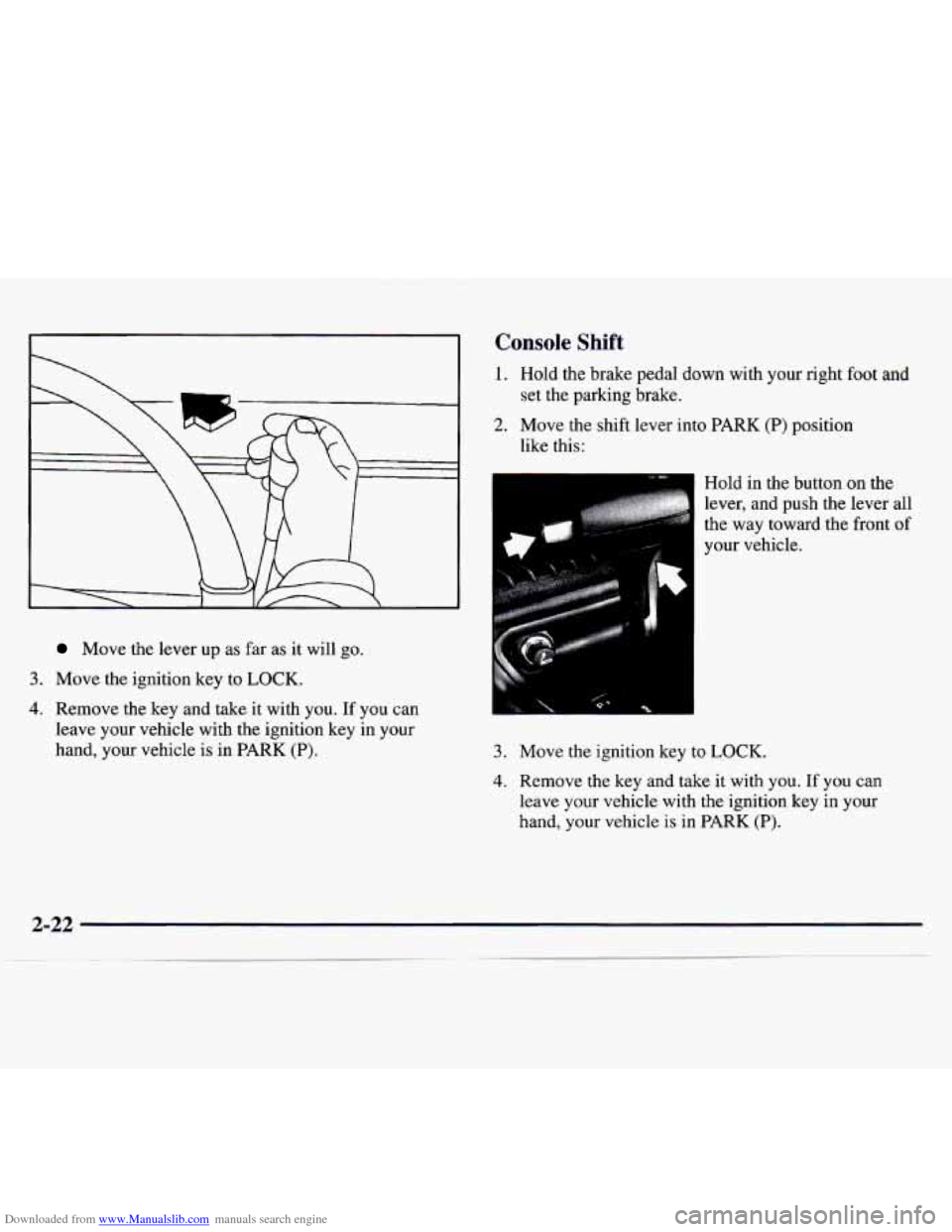
Downloaded from www.Manualslib.com manuals search engine Move the lever up as far as it will go.
3. Move the ignition key to LOCK.
4. Remove the key and take it with you. If you can
leave your vehicle with the ignition key in your
hand, your vehicle is in PARK
(P).
Console Shift
1. Hold the brake pedal down with your right foot and
2. Move the shift lever into PARK (P) position
set
the parking brake.
like this:
Hold in the button on the
lever, and push the lever all
the way toward the front of
your vehicle.
3. Move the ignition key to LOCK.
4. Remove the key and take it with you. If you can
leave your vehicle with the ignition key in your
hand, your vehicle is in
PARK (P).
Page 82 of 358
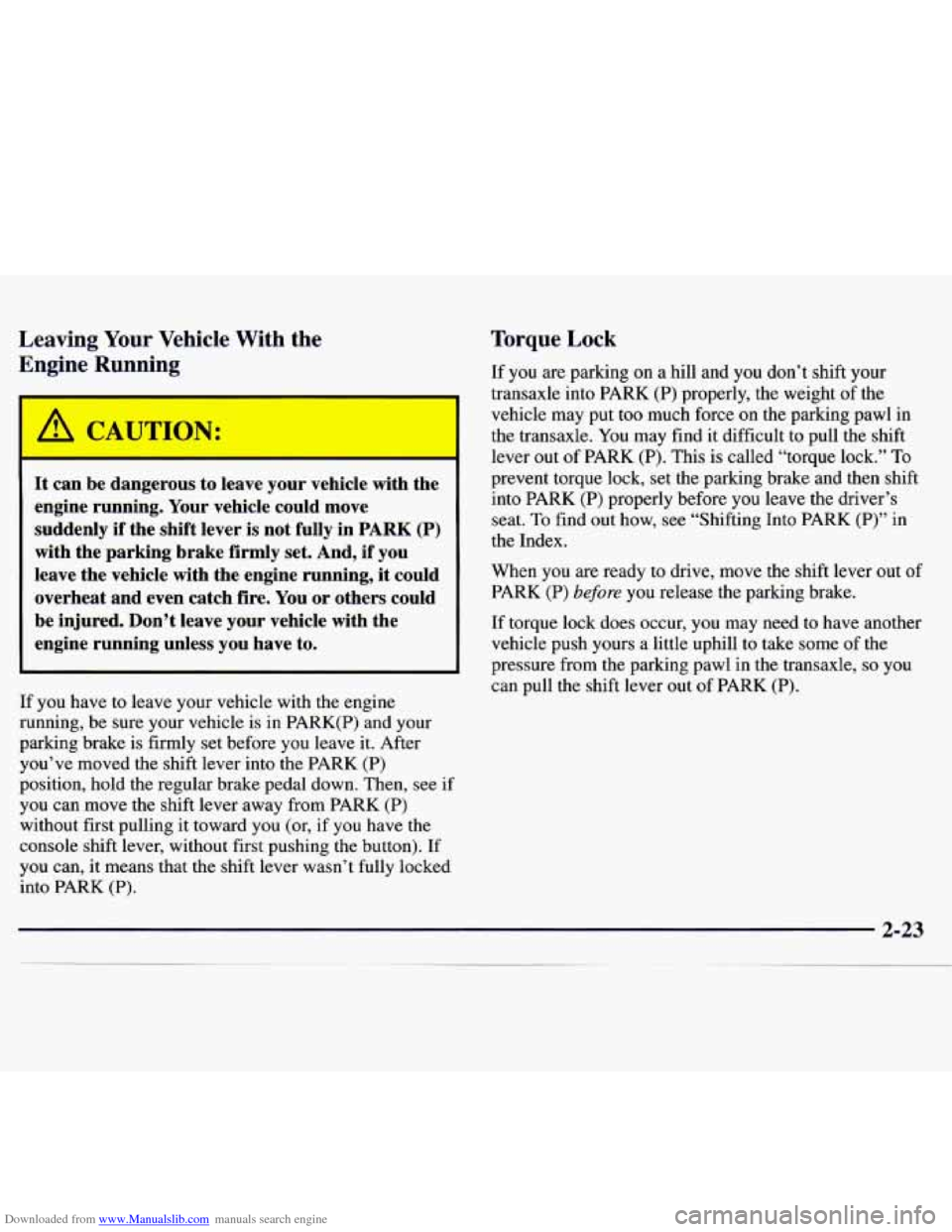
Downloaded from www.Manualslib.com manuals search engine Leaving Your Vehicle With the
Engine Running
A C ,UTIOP‘
-
It can be dangerous to leave your vehicle with the
engine running. Your vehicle could move
suddenly if the shift lever is not fully in
PARK (P)
with the parking brake firmly set. And, if you
leave the vehicle with the engine running, it could overheat and even catch fire.
You or others could
be injured. Don’t leave your vehicle with the
engine running unless you have to.
If you have to leave your vehicle with the engine
running, be sure your vehicle is in PARK(P) and your
parking brake
is firmly set before you leave it. After
you’ve moved the shift lever into the PARK (P)
position, hold the regular brake pedal down. Then, see if
you can move the shift lever away from PARK
(P)
without first pulling it toward you (or, if you have the
console shift lever, without first pushing the button). If
you can, it means that the shift lever wasn’t fully locked
into PARK (P).
Torque Lock
If you are parking on a hill and you don’t shift your
transaxle into PARK (P) properly, the weight of the
vehicle may put
too much force on the parking pawl in
the transaxle. You may find it difficult to pull the shift
lever out of PARK (P). This is called “torque lock.”
To
prevent torque lock, set the parking brake and then shift
into PARK
(P) properly before you leave the driver’s
seat.
To find out how, see “Shifting Into PARK (P)” in
the Index.
When you
are ready to drive, move the shift lever out of
PARK
(P) before you release the parking brake.
If torque lock does occur, you may need to have another
vehicle push yours a little uphill to take some of the
pressure from the parking pawl in the transaxle,
so you
can pull the shift lever out of PARK (P).
Page 83 of 358
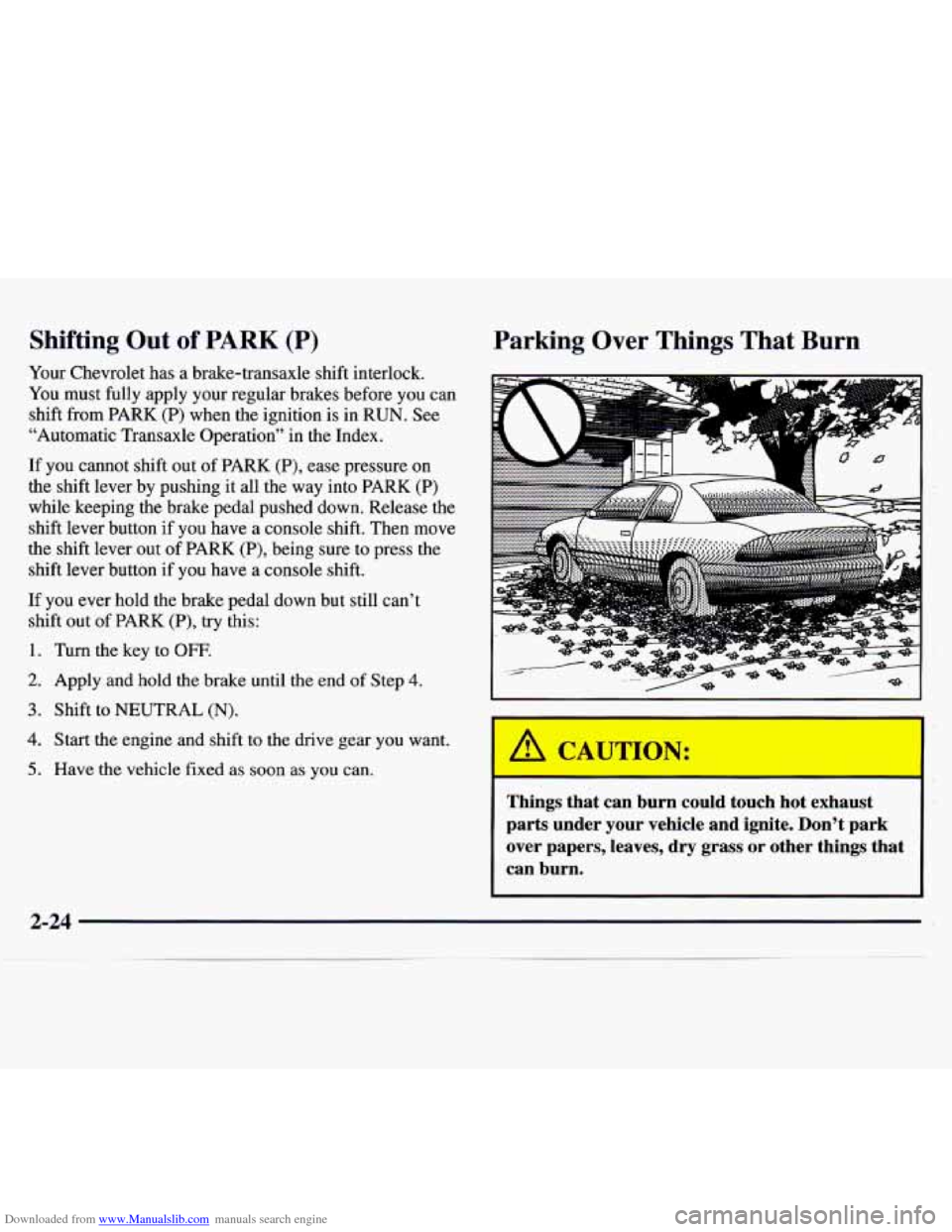
Downloaded from www.Manualslib.com manuals search engine Shifting Out of PARK (P)
Your Chevrolet has a brake-transaxle shift interlock.
You must fully apply your regular brakes before you can
shift from PARK (P) when the ignition
is in RUN. See
“Automatic Transaxle Operation” in the Index.
If you cannot shift out of PARK (P), ease pressure
on
the shift lever by pushing it all the way into PARK (P)
while keeping the brake pedal pushed down. Release the
shift lever button if you have a console shift. Then move
the shift lever out of PARK
(P), being sure to press the
shift lever button if
you have a console shift.
If you ever hold the brake pedal down but still can’t
shift out
of PARK (P), try this:
1.
2.
3.
4.
5.
Turn the key to OFF.
Apply and hold the brake until the end of Step 4.
Shift to NEUTRAL (N).
Start the engine and shift to the drive gear you want.
Have the vehicle fixed
as soon as you can.
Parking Over Things That Burn
Things that can burn could touch hot exhaust
parts under your vehicle and ignite. Don’t park
over papers, leaves, dry grass
or other things that
can burn.
2-24
Page 84 of 358
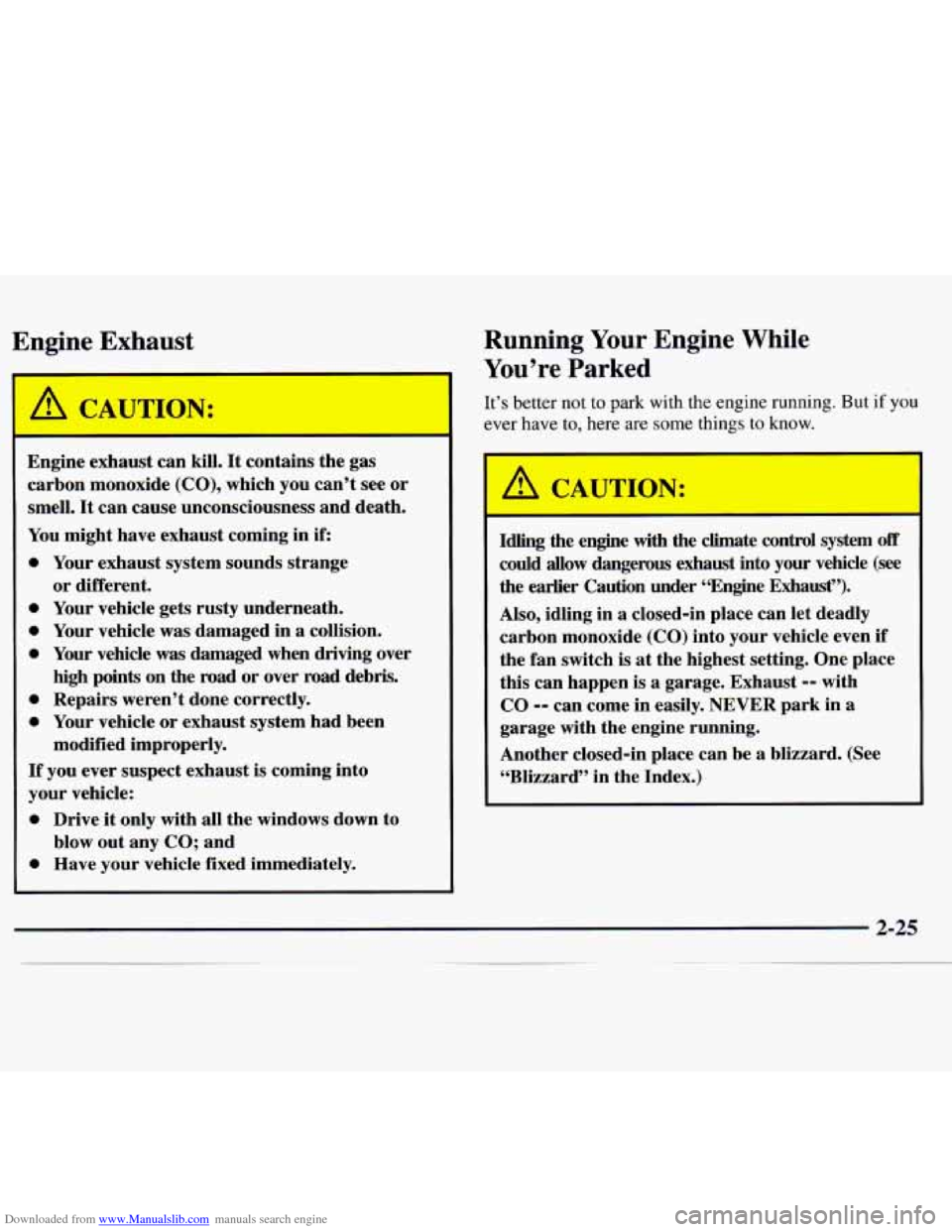
Downloaded from www.Manualslib.com manuals search engine Engine ”xhaust
m
I
Engine exhaust can kill. It contains the gas
carbon monoxide
(CO), which you can’t see or
smell.
It can cause unconsciousness and death.
You might have exhaust coming in if:
0 Your exhaust system sounds strange
0 Your vehicle gets rusty underneath.
0 Your vehicle was damaged in a collision.
0 Your vehicle was damaged when driving over
high
points on the road or over road debris.
0 Repairs weren’t done correctly.
0 Your vehicle or exhaust system had been
If you ever suspect exhaust is coming into
or
different.
modified improperly.
~ your vehicle:
1 0 Drive it only with all the windows down to
blow out any CO; and
0 Have your vehicle fixed immediately.
Running Your Engine While
You’re Parked
It’s better not to park with the engine running. But if you
ever have to, here are some things to know.
Idling the engine with the climate control system off
could allow dangerous exhaust into your vehicle (see
the earlier Caution under “Engine Exhaust”).
Also, idling in a closed-in place can let deadly
carbon monoxide (CO) into your vehicle even
if
the fan switch is at the highest setting. One place
this can happen
is a garage. Exhaust -- with
CO -- can come in easily. NEVER park in a
garage with the engine running.
Another closed-in place can be
a blizzard. (See
“Blizzard” in the Index.)
Page 85 of 358
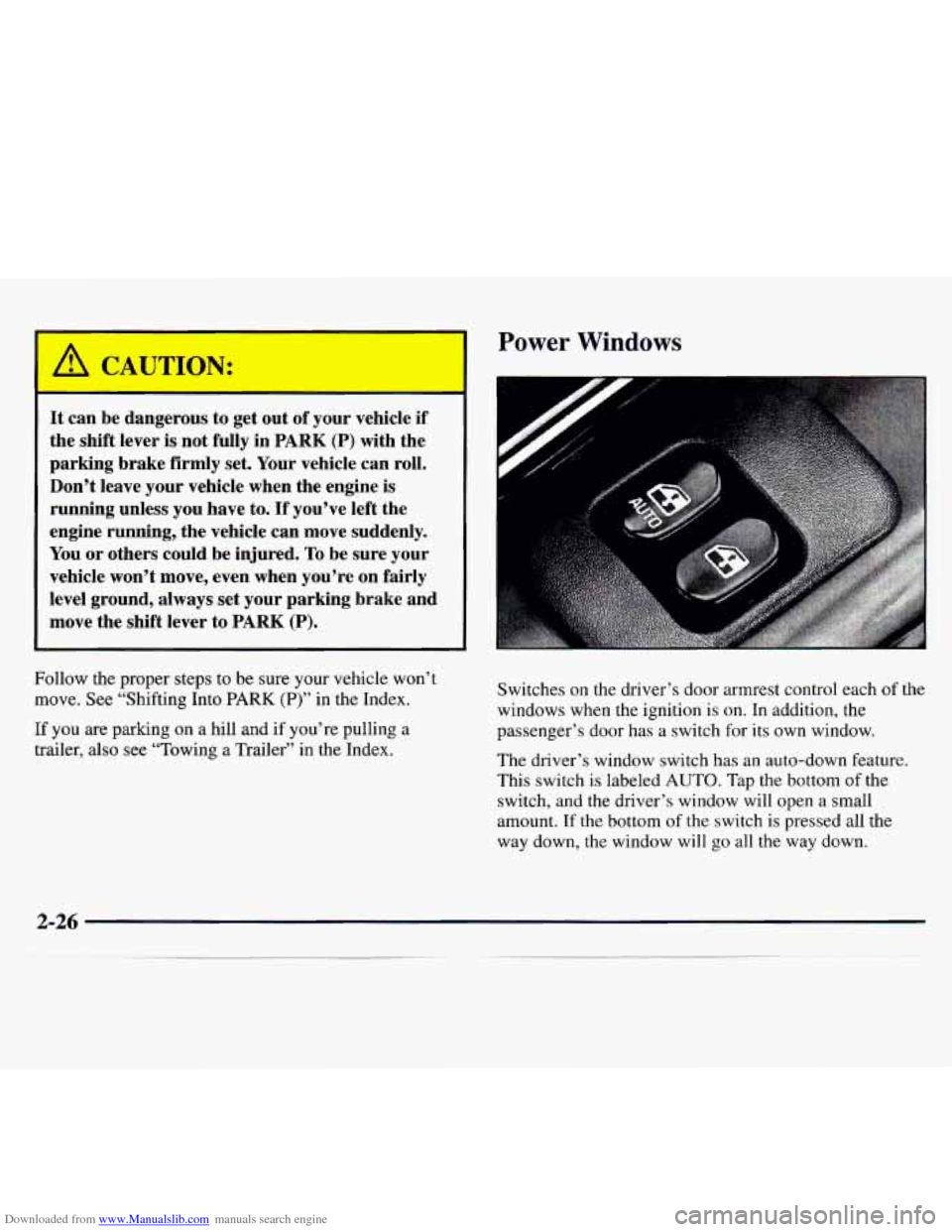
Downloaded from www.Manualslib.com manuals search engine Power Windows
It can be dangerous to get out of your vehicle if
the shift lever is not fully in
PARK (P) with the
parking brake firmly set. Your vehicle can roll.
Don’t leave your vehicle when the engine is
running unless you have to.
If you’ve left the
engine running, the vehicle can move suddenly.
You or others could be injured.
To be sure your
vehicle won’t move, even when you’re on fairly
level ground, always set your parking brake and
move the shift lever to
PARK (P).
Follow the proper steps to be sure your vehicle won’t
move.
See “Shifting Into PARK (P)” in the Index.
If you are parking on a hill and if you’re pulling a
trailer, also see “Towing a Trailer” in the Index. Switches on
the driver’s door armrest control each
of the
windows when the ignition
is on. In addition, the
passenger’s door has a switch
for its own window.
The driver’s window switch has an auto-down feature.
This switch is labeled AUTO. Tap the bottom
of the
switch, and the driver’s window will open a small
amount. If the bottom
of the switch is pressed all the
way down, the window will go all the way down.
Page 86 of 358
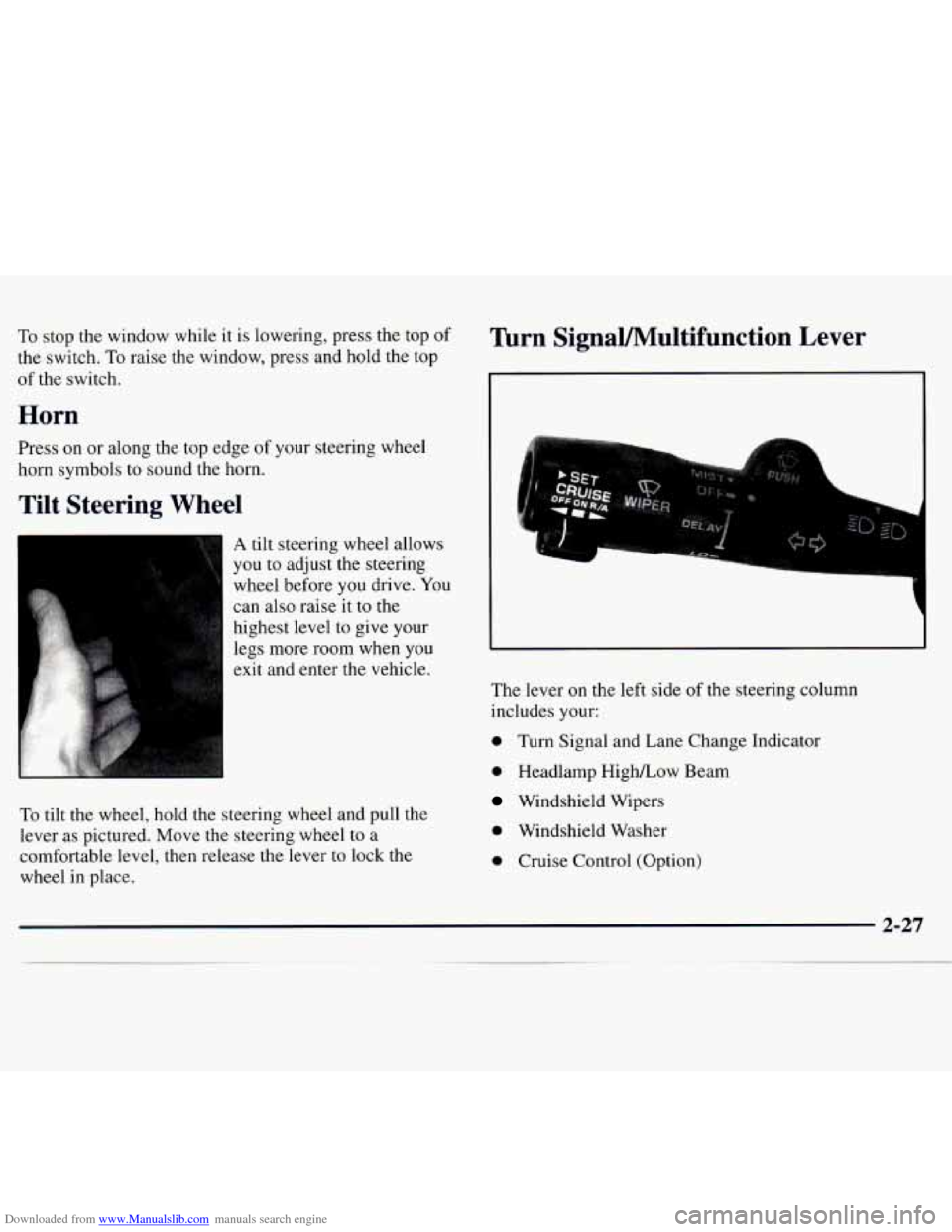
Downloaded from www.Manualslib.com manuals search engine To stop the window while it is lowering, press the top of
the switch. To raise the window, press and hold the top
of the switch.
Horn
Press on or along the top edge of your steering wheel
horn symbols
to sound the horn.
Tilt Steering Wheel
A tilt steering wheel allows
you to adjust the steering
wheel before
you drive. You
can also raise it
to the
highest level to give your
legs more room when
you
exit and enter the vehicle.
To tilt the wheel, hold the steering wheel and pull the
lever
as pictured. Move the steering wheel to a
comfortable level, then release the lever to lock the
wheel in place.
hrn SignaVMultifunction Lever
I
a
The lever on the left side of the steering column
includes your:
0 Turn Signal and Lane Change Indicator
0 Headlamp HighLow Beam
Windshield Wipers
0 Windshield Washer
0 Cruise Control (Option)
Page 87 of 358
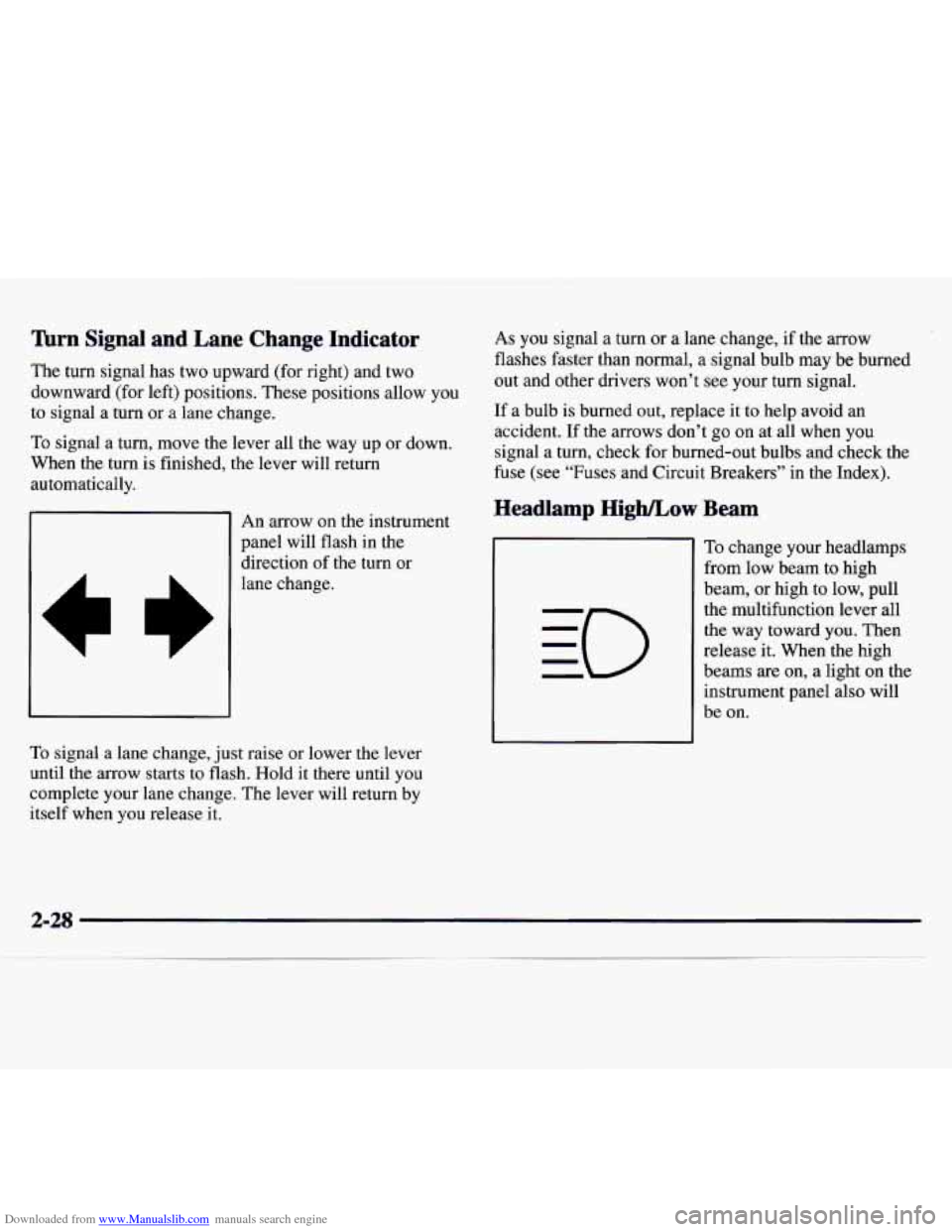
Downloaded from www.Manualslib.com manuals search engine lhrn Signal and Lane Change Indicator
The turn signal has two upward (for right) and two
downward (for left) positions. These positions allow you
to signal a turn or a lane change.
To signal a turn, move the lever all the way up or down.
When the turn is finished, the lever will return
automatically.
An arrow on the instrument
panel will flash in the
direction of the turn or
lane change.
To signal a lane change, just raise or lower the lever
until the arrow starts to flash. Hold
it there until you
complete your lane change. The lever will return by
itself when you release it.
As you signal a turn or a lane change, if the arrow
flashes faster than normal, a signal bulb may be burned
out and other drivers won’t see your turn signal.
If a bulb is burned out, replace it to help avoid an
accident. If the arrows don’t go
on at all when you
signal a turn, check for burned-out bulbs and check the
fuse (see “Fuses and Circuit Breakers” in the Index).
Headlamp HighlLow Beam
To change your headlamps
from low beam to high
beam, or high to low, pull
the multifunction lever all
the way toward you. Then
release it. When the high
beams
are on, a light on the
instrument panel also will
be on.
Page 88 of 358
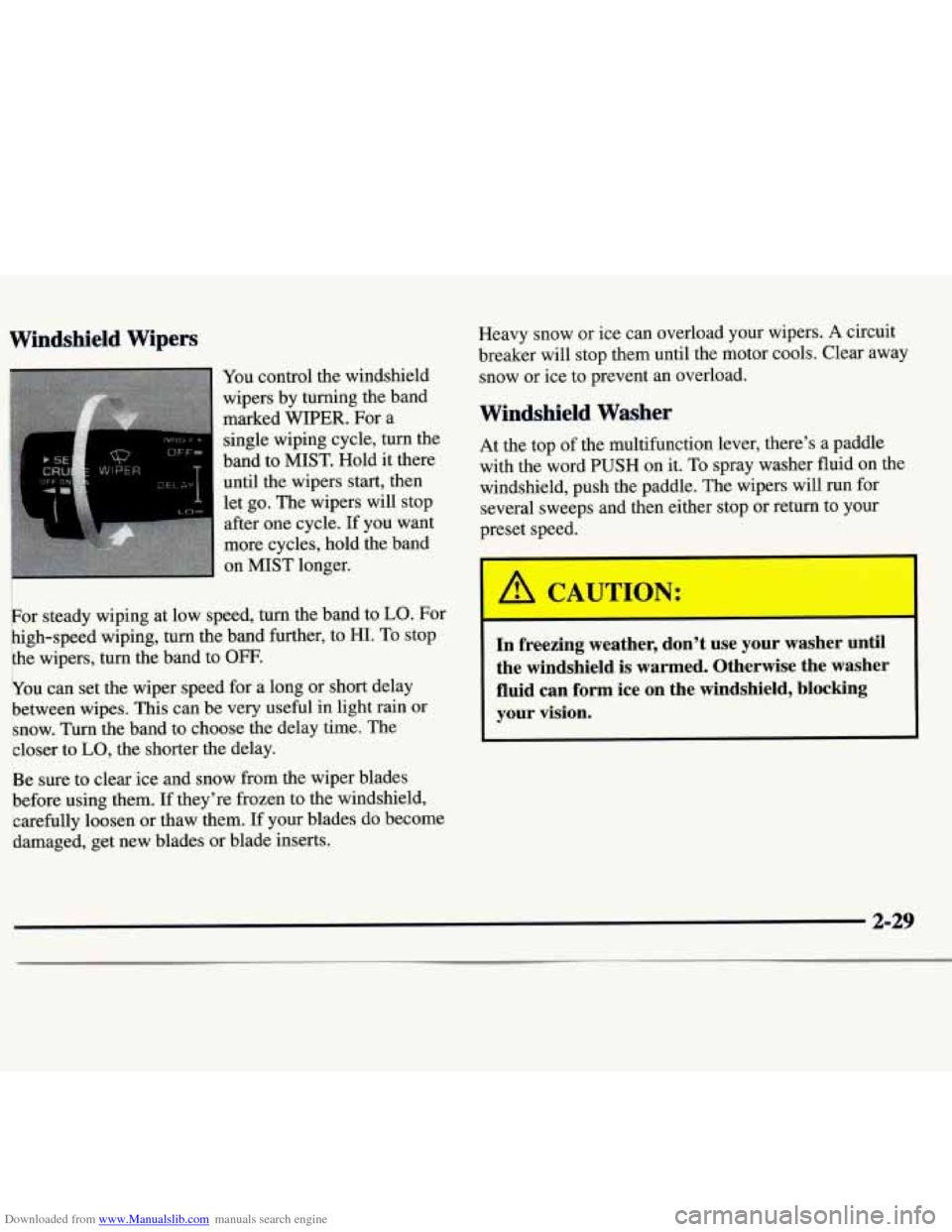
Downloaded from www.Manualslib.com manuals search engine Windshield Wipers
You control the windshield
wipers by turning the band
marked
WIPER. For a
single wiping cycle, turn the
band to MIST. Hold it there
until the wipers start, then
let go. The wipers will stop
after one cycle.
If you want
more cycles, hold the band
on MIST longer.
For steady wiping at low speed, turn the band to
LO. For
high-speed wiping, turn the band further, to
HI. To stop
the wipers, turn the band to
OFF.
You can set the wiper speed for a long or short delay
between wipes. This can be very useful in light rain or
snow. Turn the band to choose the delay time. The
closer to
LO, the shorter the delay.
Be sure to clear ice and snow from the wiper blades
before using them. If they’re frozen to the windshield,
carefully loosen or thaw them. If your blades do become
damaged, get new blades or blade inserts. Heavy snow or
ice can overload your wipers. A circuit
breaker will stop them until the motor cools. Clear away
snow or ice to prevent an overload.
Windshield Washer
At the top of the multifunction lever, there’s a paddle
with the word PUSH on it.
To spray washer fluid on the
windshield, push the paddle. The wipers will run for
several sweeps and then either stop or return to your
preset speed.
In freezing weather, don’t use your washer until
the windshield is warmed. Otherwise the washer
fluid can form ice on the windshield, blocking
your vision.
2-29
Page 89 of 358
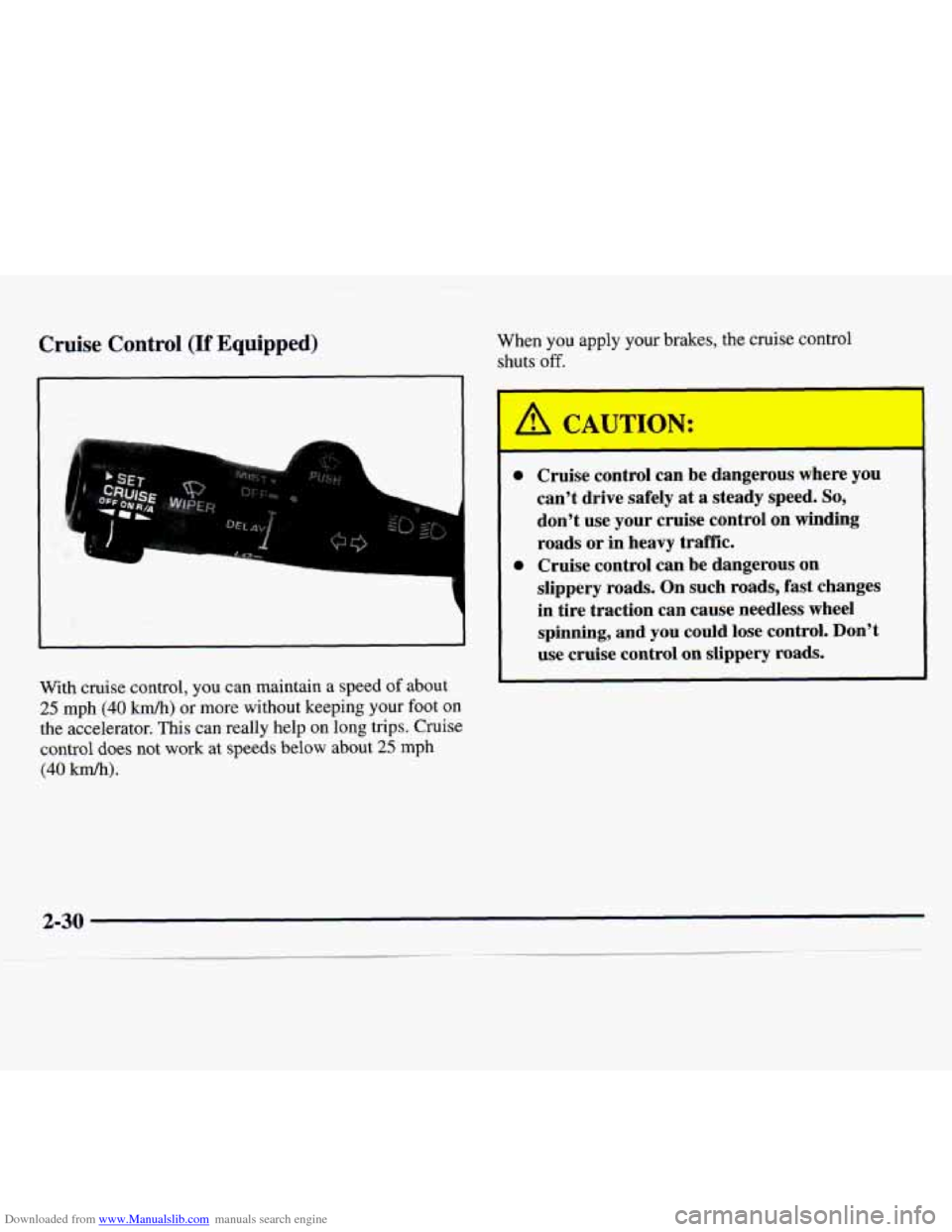
Downloaded from www.Manualslib.com manuals search engine Cruise Control (If Equipped) When you apply your brakes, the cruise control
shuts
off.
1
With cruise control, you can maintain a speed of about
25 mph (40 kmh) or more without keeping your foot on
the accelerator. This can really help on long trips. Cruise
control does not work at speeds below about
25 mph
(40 km/h).
I
a
a
-
Cruise control can be dangerous where you
can’t drive safely at a steady speed. So,
don’t use your cruise control on winding
roads or in heavy traffic.
Cruise control can be dangerous on
slippery roads. On such roads, fast changes
in tire traction can cause needless wheel
spinning, and you could
lose control. Don’t
use cruise control on slippery roads.
Page 90 of 358
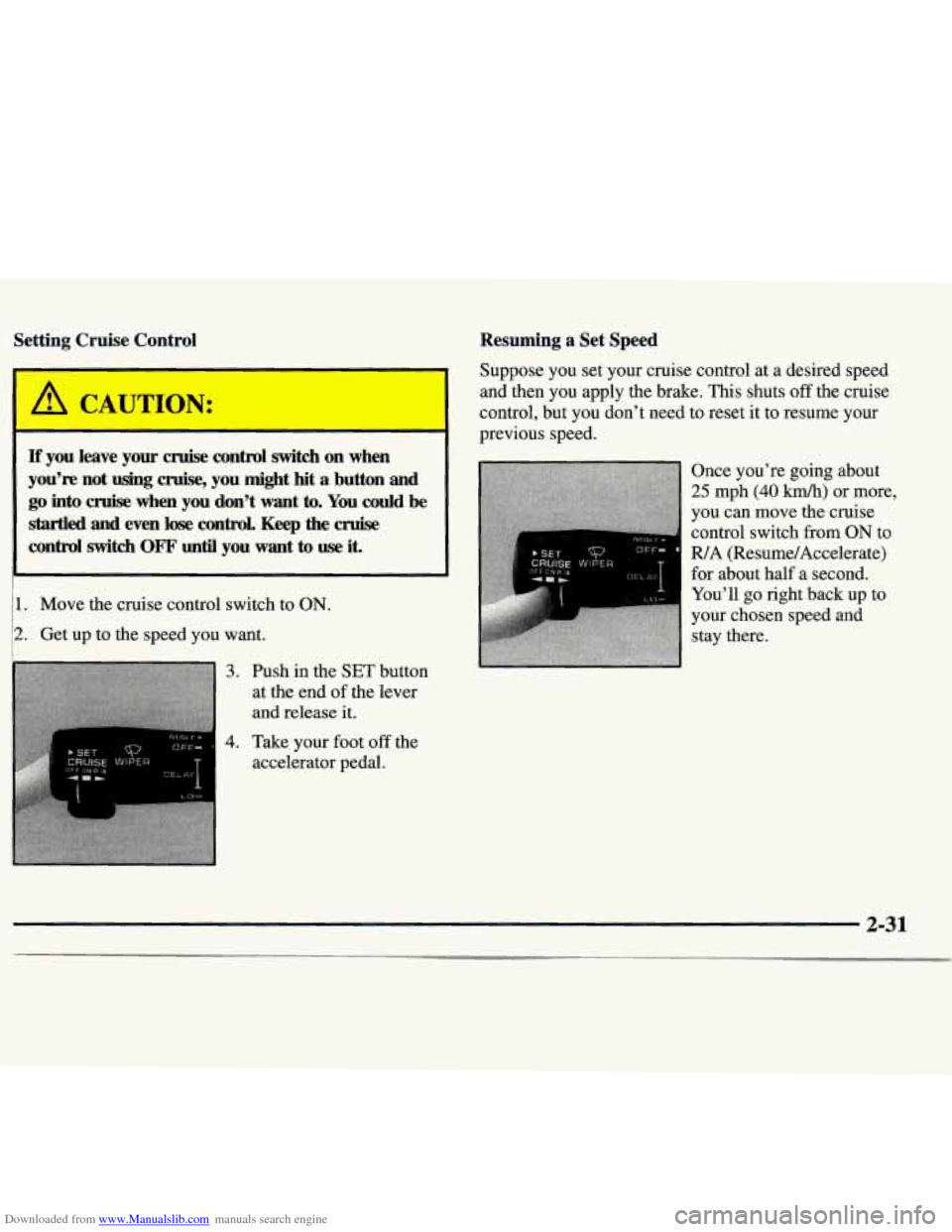
Downloaded from www.Manualslib.com manuals search engine Setting Cruise Control
1
If you leave your cruise control switch on when
you’re not using cruise, you might hit a button and
go into cruise when you don’t want to. You could be
startled and even lose control. Keep the cruise
control switch
OFF until you want to use it.
11. Move the cruise control switch to ON.
12. Get up to the speed you want.
I
3. Push in the SET button
at the end of the lever
and release
it.
4. Take your foot off the
accelerator pedal.
Resuming a Set Speed
Suppose you set your cruise control at a desired speed
and then you apply the brake. This shuts
off the cruise
control, but youdon’t need
previous speed. to
reset it to resume your
L %.a-
Once you’re going about
25 mph (40 km/h) or more,
you can move the cruise
control switch from
ON to
R/A (Resume/Accelerate)
for about half a second.
You’ll
go right back up to
your chosen speed and
stay there.
2-31